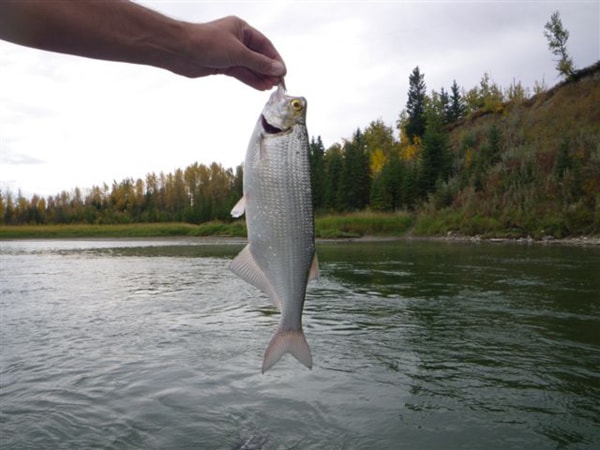Our non-temperate climate-caused conditions have kept me and most anglers off the Red Deer River during the prime times: May’s Skwala stonefly and June-July’s Brown drake mayfly hatches, for example. Again this year what we have not enjoyed is what I call a “tooperate” climate’s conditions: too cold for too long, too much rain, too much high and muddy water.
Ironically, when we got to our launch site at the Hwy 54 bridge west of Innisfail the last Sunday in September, it seemed to be tooperate all over again: that we were going to be float-fishing a river that was too low and clear under a too-bright sun that, at 2 p.m., already had the river valley too hot, with 29-30C predicted.
Of course we launched anyway in Dwayne Schafer’s drift boat, “Carpe Diem,” then Dwayne’s spouse, Marcie, left to shuttle the truck and boat downriver to our take-out point just above the Penhold Bridge.
Just after we drifted under the bridge, before I was quite ready, before I even remembered this usually happens when I float-fish the Red Deer with Dwayne, something hit my Short Black Booger as it dead-drifted deep among the rocks near shore. Heavy weight shook twice and was gone. Minutes later, it happened again.
Aside from the fact that the fish were obviously in late-season form while I was still into early season “training,” I cursed Ralph, even though he was in hospital, for bringing in his useless Alberta-wide mandatory barbless hook regulation.
Dwayne and I agree that trout can easily escape barbless hooks on weighted flies, the weight giving them something to “throw” against, just as a jiu jitsu expert uses his opponent’s weight and momentum against him. We both would have loved to see and photograph those two fish to confirm our conviction they both were big brown trout. As it happened, they would have been the last brown trout we actually saw for the rest of our six-hour drift.
Dwayne occasionally guides on and roams the river a lot, talking to anglers who report they are catching far more small age classes of brown trout than before the disastrous “200-year flood” of 2005, and also surprising numbers of rainbow trout, some of them up to 24 inches long.
Do the numbers of small browns equate to greater spawning success since 2005, and are “they” planting rainbows in the river? Who knows, “they” never tell us much anymore.
But the persistent word is there are still huge brown trout in the river from Dickson Dam down to Joffre and below.
Dwayne has seen a picture of a brown taken earlier this year on a Rapala plug, alleged to have been 36 inches long. How much would that weigh everyone wants to know. Well, I can say the new Alberta record brown trout taken from the Waterton River in 2010 was 35 inches long and weighed 21 pounds 14 ounces.
River traffic was moderate, in keeping with a day that started hot but soon clouded over with a breeze cold enough to have me opening the dry locker for my fleece-lined windbreaker. Several canoes went by and one couple on a water bed mattress. The howling jet boat armada was out, up and down, and once again we wondered whether their wake rolling up on the shore puts the skittish brown trout “down.”
Certainly we were not seeing any of the quiet, efficient rises of big trout. But the eagles, several balds and one golden, were cruising against fall’s golden backdrop.
When we did see rises, they were many and splashy, indicating either schools of rocky mountain whitefish, or goldeye.
Pitch a hopper imitation over there, and, especially if you dragged it on purpose, and they quickly proved to be goldeye, some of them sizeable. This is a lot of fun and the Red Deer’s consolation prize for being skunked by the trout.
But you soon burn out on having your flies chomped bald-headed by raspy-toothed goldeye mouths, and avoid casting to those splashy rises, especially after Dwayne boated a slimy, stinky hammer-handle pike from among a pod of rising goldeye. As it grew darker, we scoured water near the banks for those big, quiet trout rises.
Just before the take-out ramp we saw a couple, but they would not take what Dwayne was offering.
Dwayne had been telling me that some good browns had been caught recently away from the banks and out in the faster riffles of the river. To prove that pudding, as the Penhold Bridge came into view ahead, we flushed a huge brown off a shallow gravel bed that left a wake like a U-boat as it fled for deeper water.
Then, as we made the turn into the A – Soo – Wuh – Um Day Use Facility’s landing ramp, a horse and rider splashed across the river and into the sunset, a perfect end to my only float-fishing trip of the year on one of those rivers that always runs in my mind.
Bob Scammell is an award-winning outdoors writer living in Red Deer.
